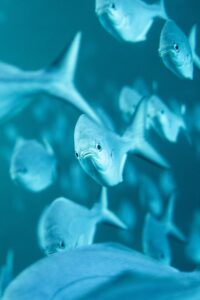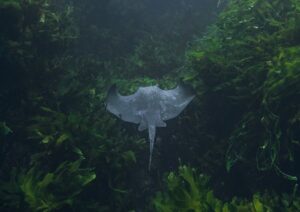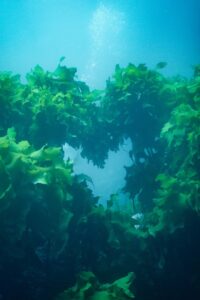I’m putting together a series of posts highlighting influential photography NFT creators, with each post dedicated to a single artist. In this way I’ll be able to share my own DYOR, bring awareness to important photographers, and better clarify to beginners what the photography NFT market looks like right now in order to set a benchmark for future comparisons.
In this series I have written of:
Today I’m interviewing Gabriella Morton, whose mission it is to bridge the gap between art and science to create a stronger narrative around sustainability “by grasping onto my fascination for our natural world in the hope of helping others see our planet working as a whole.” With an eye for the beauty of simplicity, Gabriella describes her art as “visual metaphors” while others state she has the ability to “infer much with few visual elements”.
Gabriella goes to great lengths to ensure her work produces a positive environmental impact, donating 10% of the profits of her Searenity collection to protecting the Poor Knights Islands Marine Reserve, for example. In addition, Gabriella created Samsung’s genesis NFT in collaboration with illustrator Snucks. The 1/1 is now sold on Foundation where 100% of proceeds were donated to Live Ocean. “The collector now owns a piece of Samsung history and can feel empowered about supporting a charity that partners with exceptional marine scientists, innovators and communicators to scale up action for a healthy ocean.”
Clearly, Gabriella is a photography NFT creator deserving of more attention. With that, let’s get to some Q&A…
An interview with @gabriellamort
What makes a good NFT experience?
Creatives are given keys to doors they didn’t even know existed. They can cut the middlemen and advance passion projects to the driver's seat. We've never had so much freedom for producing non-commercial work while gaining sustainable financial compensation which has the potential to enable a well-nurtured flow state.
What exactly is NFT Photography?
I think the term NFT Photography is often misused. In most cases it’s used to represent just the transactional medium in which it’s sold - irrelevant to its genre, therefore it doesn’t make sense to use it to categorize, define or represent one's style. I would say the best use case I’ve seen of ‘NFT Photography’ is through Transient Labs technologies. Unless someone is implementing custom code to make the photograph interactive in a way that evolves and transforms the photo based on a variable I wouldn’t use it as a label.
Why do you think NFTs + photography work well together, as a product?
Together they demonstrate the benefits of digital ownership through the future of image licensing. It’s a much more effective way to track provenance, usage rights, and royalties as opposed to traditional models.
Give me your 30 second elevator pitch. Sell me your art…
I enjoy sourcing hard to digest concepts and reformatting them so that visual learners can understand. Facts need storytellers to breathe life into them so I use photography as my vessel. By grasping my fascination for our natural world I capture thought-provoking imagery that helps others see the planet as a whole. I discovered by coming from a place of awe we can bridge the gap between art and science to create a stronger narrative around sustainability. I’m breaking down ideas that the viewer may not have explored otherwise, and I want people to walk away from one of my pieces feeling like they’ve learned or concluded something.
Tell me about your favorite NFT experience.
Hands down the IRL exhibition set up by TyanHaus in January - the only artist-orientated NFT event hosted in New Zealand to date. Meeting my peers in person was a buzz that’s hard to shake. It ignited something within us that accelerated our friendships, collabs, and future endeavors tenfold.
How do you determine your NFT floor price?
I weigh up how hard it would be to replicate the shot along with the rarity of the conditions and the costs involved behind the scenes.
How do you determine what kind of collection to offer? Deciding on Editions vs. Standalones vs. Collections?
I think a lot about my digital footprint and how that translates into energy usage. Most of the time it’s more sustainable for me to produce high-value 1/1s than lower-tiered quantifiable editions.
How much do you typically make per NFT sale? Is your business sustainable from NFT sales alone?
On Foundation my work has sold between 1-5 ETH per piece. As I’m recovering from full-body injuries after a high-speed motor vehicle accident and unable to take on new projects - reviving my past work through NFTs is currently my only source and I’m grateful to have this avenue as an option. Currently, I’m only offering my work printed with the purchase of the corresponding NFT. My top priority is recovery so holding my camera as I used to will be a massive milestone I aim to hit later this year. I have had so much internal character development over the past 18 months that I’m itching to express it visually.
Few photographers are doing something in the form of creation that is exclusive to an image being an NFT. With that, NFT photography isn’t a genre of photography - it’s a form of consumption. How are you, or how do you, plan to create a new genre? Or is the goal to increase eyeballs and consumption?
At the moment people are sitting on decades worth of pre-existing work but we are beginning to see a shift in artists creating purely for the metaverse. I’m still deciding what that looks like for me but I think it would be a shame to waste the opportunity. Collaborating with a 3D artist would certainly broaden the limits of my imagination.
Were you, as a photographer, already well-established before entering into the world of NFTs? Did you already have crypto experience?
I have used photography as both a creative expression and as my profession for about a decade before dabbling on the blockchain. I’m grateful for having already built a strong purpose behind my work because it meant I could be very specific and intentional with what I felt was worth immortalizing. I had already invested in Ethereum which helped it feel less intimidating to begin with.
Photographers as a whole could benefit from being a little more business savvy, what are some key actions you took to establish your photography career?
Absolutely - It’s a lot to juggle being your own personal pitcher, producer, director, executor, editor, marketer, and accountant. I think a key message I keep at the forefront of everything I release is artistic integrity. I want my work to be timeless so I always think twice before jumping on a trend. You’ve got to zoom out as short-term temptations can be damaging to your long-term reputation.
At what point did you decide to jump into NFTs?
I’d been keeping up to date with uprise through all the spare time we had at home over the lockdowns but I’d always thought ‘crypto art’ was strictly 3D, pixel or computer generated. It wasn’t until about April of 2021 that I saw a growing community of artists minting photography and something clicked where I knew my previous passion projects could be reborn. It wasn’t long after that, that I became bedridden, so with the gift of time I began to fall pretty deep down the rabbit hole.
Unfortunately, unlike the world of PFP's such as Bored Apes and Punks, there isn't a cool factor or social media flex associated with photography NFTs within the community. How can photographers resolve this issue? Is there a place for photography PFPs and is anyone already doing this?
It’s been such a compliment to see some of my collectors rock my photography in their Twitter banner, I’ve even had one use a piece as the background in their PFP! Because true 1/1 art can’t compete with the volume of holders from generative projects, it makes sense why ‘flexing’ is fewer and further in between. Often because photography involves much more light, detail and depth it’s genuinely harder for people to identify from afar and less effective or iconic when viewed small. But there is a gap in the market for tasteful curation and so it’s always admirable to see collectors discuss and display photography with intention in their own galleries. I see a huge opportunity for virtual reality experiences and I like where OnCyber is headed.
I see a lack of traditional NFT-type tokenomics missing from photography NFT collections - there’s no rarity type mechanism for speculators. Why do you think this is the case? Do you see photography NFTs going this direction? Why or why not?
I think a lot of the photography minted today was never shot with rarity in mind. But it also comes down to education - when most artists make their first mint on a platform they're using the marketplace's default contract that doesn’t offer much customization. With the UX for making your own custom contracts through applications like Manifold, I see people taking a lot more interest and effort into the metadata. With this in mind, when concepts get shot specifically for the space, I think we will see rarity mechanisms used more creatively.
What’s the best marketplace for photography NFT creators? Is this different from the best marketplace for photography NFT investors?
I think the narrative of one marketplace being better than another can be damaging for emerging artists. But at the moment I lean towards Foundation as it’s less directory feeling than OpenSea, and the fees are 3 times less than its gated competitors. I’m excited for the development of discoverability across all platforms and will happily welcome some healthy competition.
S.W.O.T ANALYSIS of your business! Strengths? Weaknesses? Opportunities? Threats?
Strengths
- Concept
- Story
- Technique
Weaknesses
- Introversion
- Marketing/branding
- Public speaking
Opportunities
- Collaborations
- Curation
- Education
Threats
- Injuries/disabilities
- Losing momentum
- Saturation
In closing …
I’d like to close with all the important links i could find on @gabriellamort as well as some of my favorite shots from her ‘Searenity’ collection.
- Twitter - https://twitter.com/gabriellamort
- Opensea - https://opensea.io/collection/searenity
- Deca gallery - https://deca.art/ella
- Website - https://www.gabriellamorton.com/
- Foundation - https://foundation.app/@gabriellamorton
- Instagram - https://www.instagram.com/gabriellamorton/
- Products - https://www.gabriellamorton.com/products/
- Planet - https://www.gabriellamorton.com/planet/
- People - https://www.gabriellamorton.com/people/
- Film - https://www.gabriellamorton.com/film/
- Prints - https://www.gabriellamorton.com/prints/
- Press - https://www.gabriellamorton.com/press/
Gabriella on ‘Searenity’:
“Hypnotized between the vivid vertebrate & illuminated invertebrate presence beneath the surface, this series from Aotearoa’s, Poor Knight Islands, explores our Moana from a curious lens. Straight out of isolation and into an ocean full of so many critical issues, it all becomes a bit overwhelming: mining, sedimentation, oil spills, coral bleaching, sea-level rise, plastic pollution, whaling, shark finning, and commercial fishing are all major threats to unique ecosystems like the one found at Poor Knight’s…”


